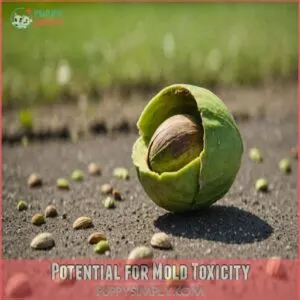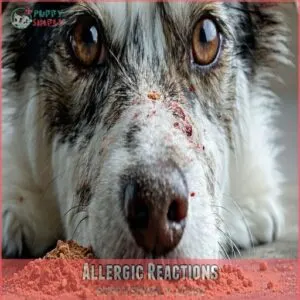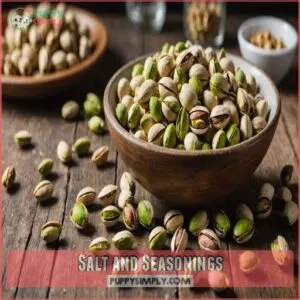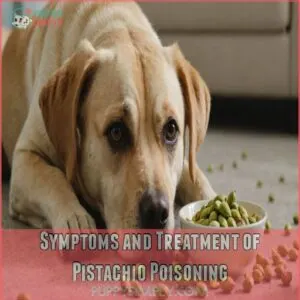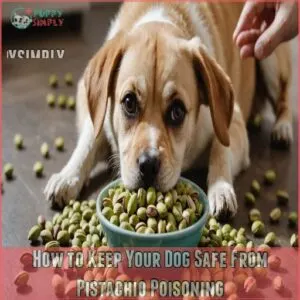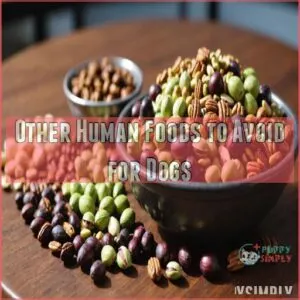This site is supported by our readers. We may earn a commission, at no cost to you, if you purchase through links.
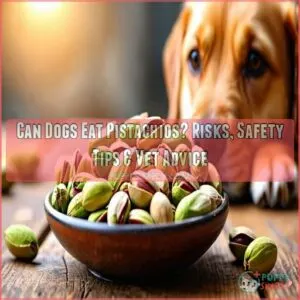
We’ll explore the potential dangers and safer alternatives in more detail, including which nuts are okay for your dog to enjoy. You might be surprised!
Table Of Contents
- Key Takeaways
- Risks of Pistachios for Dogs
- Can Dogs Eat Pistachios Safely
- Healthy Alternatives to Pistachios
- What Happens if My Dog Eats Pistachios
- Symptoms and Treatment of Pistachio Poisoning
- How to Keep Your Dog Safe From Pistachio Poisoning
- Other Human Foods to Avoid for Dogs
- Frequently Asked Questions (FAQs)
- Are pistachios bad for dogs?
- Can dogs eat chili pistachios?
- What should I do if my dog ate pistachio nuts?
- How many pistachios can a dog eat a day?
- Can dogs eat pistachio ice cream?
- Can dogs eat pistachios from Aspergillus mold?
- What happens if a dog eats pistachios?
- How many pistachios can a dog eat a day?
- What nuts are toxic to dogs?
- Can dogs have almonds or pistachios?
- Are pistachios safe for puppies?
- Can pistachios cause allergies in dogs?
- Can pistachios affect a dogs behavior?
- How often can dogs eat pistachios?
- Can pistachios improve a dogs coat health?
- Conclusion
Key Takeaways
- Keep pistachios away from your dog due to the choking hazard and high-fat content, which can lead to digestive problems.
- Be vigilant about possible mold in pistachios, as it can cause aflatoxin poisoning, affecting your dog’s liver.
- Opt for safer treats like carrots and green beans, or choose nuts like peanuts and almonds in moderation.
- Always consult your vet if your dog consumes pistachios or shows any symptoms like vomiting or lethargy.
Risks of Pistachios for Dogs
Feeding pistachios to your dog might seem like a fun treat, but it actually poses several risks ranging from choking hazards to potential mold toxicity.
While the nuts themselves aren’t toxic, their high-fat content and possible allergens can lead to serious health issues.
Choking Hazard
Pistachios can be a real mouthful for small dog breeds, turning snack time into a choking hazard.
Shell size matters since dogs eat pistachio shells without a second thought, risking obstruction.
Instead, offer safe snacks and focus on choking prevention.
Keep in mind:
- Small dog breeds
- Dog size matters
- Shells can block airways
- Avoid pistachio poisoning
- Prioritize safe snacks
High-Fat Content
Ever notice how dogs seem to find anything flavorful irresistible?
Pistachios, with their high-fat content, are a sneaky culprit in terms of potential doggy digestion dilemmas.
If you’re considering pistachios as a treat, you might be interested in pistachio dog treats that are specifically formulated for canine nutrition.
This deliciously troublesome nut can lead to weight gain and
Potential for Mold Toxicity
When considering your pup’s diet, keep moldy pistachios off the menu.
These nuts can grow Aspergillus flavus, leading to dangerous aflatoxin poisoning.
Here’s what to watch for:
- Liver Damage: Mycotoxins harm your dog’s liver.
- Vomit and Lethargy: Classic signs of pistachio poisoning.
- Jaundice Alerts: A warning sign of severe toxicity.
Stay vigilant, and consult your vet!
Allergic Reactions
Mold isn’t the only worry.
Dogs can also run into trouble with pistachio allergies.
Signs of allergies might make your pup itch like it’s rolling in a pile of itchy sweaters.
Look out for dog symptoms such as itching, swelling, or bald patches.
If you notice these, call the vet.
They’ll suggest treat alternatives for your furry friend’s food sensitivities.
Salt and Seasonings
A tiny pinch of salt might seem harmless, but seasoned pistachios are a big no-no for your furry friend.
High salt content in pistachios can lead to salt poisoning, causing serious issues like vomiting and diarrhea.
Stick to unsalted, plain pistachios (if you must give them at all!), and remember, moderation is key.
Better yet, explore healthier, safer alternatives like carrots or green beans!
Your pup will thank you for it.
Can Dogs Eat Pistachios Safely
So, you’ve considered the risks of pistachios for dogs, but what about feeding them safely?
While they’re not toxic, exercise caution.
Here’s how to proceed:
- Choose Wisely: Opt for plain, unsalted, and shelled pistachios to minimize risks.
- Moderation: Offer in small amounts—just one for small dogs, up to five for large breeds.
- Monitor Closely: Watch for signs of pistachio poisoning like vomiting or diarrhea.
Stay vigilant, and when in doubt, consult your vet for personalized advice.
Healthy Alternatives to Pistachios
Instead of pistachios, treat your dog to some safe nuts like peanuts or cashews, or opt for healthy veggies such as carrots and green beans.
These alternatives provide nutritional benefits and also keep your furry friend away from pistachio-related health risks, leaving you both with wagging tails.
Safe Nuts for Dogs
Not all nuts are bad for dogs, and knowing which ones are safe can make snack time a breeze.
Peanuts, cashews, and almonds are safe nuts for dogs if given in moderation.
Remember, a handful of nuts for you means just a couple for your pup!
For those looking for other healthy options, you can try homemade healthy dog treats.
However, avoid macadamia nuts and pecans.
Vegetables as Healthy Treats
When you’re thinking of healthy snacking for your furry friend, vegetables are a fantastic treat alternative to pistachios.
They’re packed with nutritional value and offer numerous vegetable benefits.
To explore more dog-safe options, check out products related to dog safe vegetables.
Dog-safe options like carrots, cucumbers, and green beans provide crunch without the risk of pistachio poisoning dogs might face.
What Happens if My Dog Eats Pistachios
Your pup just gobbled up some pistachios? No panic, but keep a watchful eye.
These nuts can lead to digestive upset, pancreatitis, or even worse like aflatoxin poisoning, and are also high in xylitol risks.
Pistachios are known for high fat content, which can bring kidney issues or liver damage to light.
Sure, dogs
Symptoms and Treatment of Pistachio Poisoning
If your furry friend gets into a stash of pistachios, you might notice symptoms like vomiting, loss of appetite, or even jaundice.
It’s important to act quickly and contact your vet who can help with treatments to get your pup back to tail-wagging health.
Loss of Appetite
Besides gastrointestinal distress, a significant sign of pistachio poisoning in your furry friend is a sudden loss of appetite, also known as food refusal.
This appetite change, coupled with lethargy, might indicate pistachio toxicity.
Don’t panic! Immediate veterinary attention is key.
Early intervention can prevent serious complications like pancreatitis.
Dietary changes are essential post-poisoning.
Vomiting
Did your furry friend just lose their appetite? That could lead to vomiting, a common symptom of pistachio poisoning.
If you suspect pistachio toxicity, make sure to check out products related to pistachio dog safety Pistachio Dog Safe Products.
Watch for these red flags:
- Vomiting frequency: How often?
- Vomiting causes: What’s
Orange-colored Urine
Spotting orange-colored urine in your dog might give you the heebie-jeebies, but it can indicate liver health issues or urinary tract infection due to pistachio poisoning.
Aflatoxins from moldy nuts could be the culprit, leading to dehydration and kidney disease.
Don’t wait—reach out to your vet pronto for tests and treatment if you notice this peculiar hue.
Lethargy
When dogs eat pistachios, lethargy is a telltale sign something’s amiss.
If your furry friend seems like a couch potato or unusually tired, watch for other symptoms.
Quick action can help:
- Check energy levels
- Monitor sleep patterns
- Look for pistachio shells
- Note any dog fatigue
- Call the vet if concerned
Catch it early for safer tails!
Jaundice
Seeing your pup with jaundice, the yellowing of gums and eyes, might cause panic.
It’s linked to liver function and bilirubin levels, often due to pistachio poisoning.
Though pistachios aren’t toxic to dogs, they pose health risks.
Keep an eye for symptoms.
Prompt treatment options include vet visits for supportive care.
Avoid pistachios to dodge any pistachio allergy dogs might develop.
How to Keep Your Dog Safe From Pistachio Poisoning
Keeping your dog safe from pistachio poisoning starts with being vigilant about the snacks you offer and watching for any unusual symptoms.
If your furry friend sneaks a few pistachios, stay calm but reach out to your vet for advice, because sometimes a little extra caution goes a long way in avoiding a surprise vet visit.
Monitor for Symptoms
After spotting troubling symptoms like vomiting or diarrhea in dogs who’ve eaten pistachios, watch them closely.
Keep an eye out for these signs:
- Choking: Difficulty breathing or coughing.
- Lethargy: Unusual tiredness or weakness.
- Jaundice: Yellowed gums or eyes.
- Behavior changes: Unusual whimpering or restlessness.
Prompt action helps keep tail-wagging regular without unpleasant surprises!
Contact Your Veterinarian
Because early intervention is key, don’t hesitate to contact your veterinarian if you suspect pistachio poisoning.
Even if your dog seems fine, a vet visit is best, as some nuts, like almonds, can cause pancreatitis in dogs due to their high fat content almonds and pancreatitis.
They can assess your dog, offer expert advice, and discuss potential treatment options.
Remember, preventing problems
Bloodwork and Urine Tests
If you suspect pistachio trouble, a vet’s bloodwork and urine tests are like detective work in a mystery novel.
They’ll uncover aflatoxin poisoning signs or pancreatitis threats lurking behind the scenes.
Here’s how testing helps:
- Bloodwork analysis reveals liver health clues.
- Urine analysis checks kidney function.
- Aflatoxin detection targets toxic exposure.
- Liver failure prevention safeguards your pup’s safety.
Other Human Foods to Avoid for Dogs
You’re not alone if you’ve given in to those puppy eyes and shared a snack, but some human foods are downright dangerous for dogs.
While pistachios are worrisome, nuts like macadamias, black walnuts, and pecans can be toxic, causing serious health issues that might have you rushing to the vet.
Toxic Nuts for Dogs
Regarding feeding your furry friend, stay clear of toxic nuts.
Certain nuts can spell disaster, leading to nut allergies or more severe issues like nut toxicity in dogs.
Let’s see the culprits:
| Nut | Risk Level | Symptoms |
|---|---|---|
| Black Walnuts | High | Lethargy, Seizures |
| Pecans | High | Vomiting, Diarrhea |
| Macadamia Nuts | High | Not Discussed Here |
Stick to safe alternatives for dog safety.
Macadamia Nuts
Toxic nuts give dogs more than their fair share of trouble.
Macadamia nuts, though seemingly harmless, belong on the "never feed" list.
Why? Consider these risks:
- Macadamia nut toxicity leads to vomiting and weakness.
- Dog health risks appear after just a few nuts.
- Macadamia poisoning symptoms are often severe.
- Safer nut alternatives exist, so skip the macadamias!
Black Walnuts
Even the smell of black walnuts can spell trouble for dogs.
Black walnut toxicity can lead to serious health issues.
Think of it like offering candy at a dog park—tempting but disastrous!
Table of Canine Dangers
| Danger | Description |
|---|---|
| Black Walnuts | Toxic to dogs |
| Pistachios | Risky, may cause health issues |
Stick to dog-safe treats instead!
Pecans
After black walnuts, pecans for dogs sound tempting but hold your horses!
Pecans can lead to digestive troubles and even allergies.
Their high-fat content isn’t a friend to Fido’s waistline.
Instead of risking pecan toxicity, swap them for dog-safe veggies or nuts.
Cozy up with your pup and a crunchy carrot—a perfect pecan substitute!
Frequently Asked Questions (FAQs)
Are pistachios bad for dogs?
Pistachios aren’t toxic, but they pose risks for dogs, like choking and weight gain.
It’s best to avoid them.
Choose dog-safe veggies instead, keeping Fido healthy and happy, and consult your vet before sharing human snacks.
Can dogs eat chili pistachios?
Imagine your dog encountering a jalapeño—a spicy tale!
Chili pistachios pose similar risks: the spice and salt can harm their digestive system.
Stick to safer snacks like carrots or plain nuts for your furry friend’s health.
What should I do if my dog ate pistachio nuts?
If your dog ate pistachio nuts, keep an eye out for symptoms like vomiting or diarrhea.
Contact your vet if you notice any issues.
It’s always wise to seek professional advice when your pet eats something questionable.
How many pistachios can a dog eat a day?
Feeding your dog pistachios is like giving a hamster roller skates—possible but risky.
Pistachios are a risky treat for dogs.
Small dogs can have one, medium up to three, and large dogs four or five.
Always unshelled and unsalted for safety.
Can dogs eat pistachio ice cream?
Don’t let your dog eat pistachio ice cream.
With sugar, milk, and potential nut hazards, it’s a recipe for tummy troubles.
Consider safer treats like plain yogurt or even some dog-friendly peanut butter instead.
Can dogs eat pistachios from Aspergillus mold?
No, pistachios with Aspergillus mold are dangerous for your dog. Aflatoxins in the mold can cause liver damage. Keep your pup safe; skip the moldy nuts! Choose safer treats instead.
What happens if a dog eats pistachios?
Ever wonder what happens when dogs nibble on pistachios?
They risk choking, stomach upset, or serious health issues like pancreatitis.
While they might savor the taste, the risks far outweigh any potential benefits for your furry friend.
How many pistachios can a dog eat a day?
For your furry friend, limit pistachios to an occasional treat: one for small dogs, two to three for medium, and four to five for large dogs.
Removing shells prevents choking.
Always consult your vet for specifics.
What nuts are toxic to dogs?
Macadamia nuts, pecans, and black walnuts are toxic to dogs and should be avoided.
They can cause symptoms like weakness, vomiting, and tremors.
Always stick to safe options like peanuts or almonds, preferably unsalted and in moderation.
Can dogs have almonds or pistachios?
Think Fido dreams of gourmet pistachios?
Stick to almonds‘ plain, unsalted kindness instead.
Sure, pistachios aren’t toxic, but their risks outshine benefits.
As for almonds, occasional modest bites are fine.
When in doubt, veggies are dog delight!
Are pistachios safe for puppies?
Pistachios aren’t the safest treat for puppies.
They pose choking hazards and might upset their tummies.
While your pup might give those puppy-dog eyes, stick to safer snacks like carrots or green beans.
Always consult your vet first!
Can pistachios cause allergies in dogs?
Imagine your dog sneezing like it’s auditioning for a role in a cartoon.
Pistachios can cause allergies in dogs, triggering reactions like itching, hives, and gastrointestinal upset.
Always introduce new foods cautiously and consult your vet.
Can pistachios affect a dogs behavior?
While pistachios aren’t toxic, they’re not ideal for your dog.
Large amounts might upset their tummy or cause other issues.
It’s best to stick to dog-friendly treats.
Consult your vet if you’re unsure.
How often can dogs eat pistachios?
You should limit your dog’s pistachio intake to an occasional treat.
Ideally, offer only plain, unsalted, and shelled pistachios.
A small dog can have one, a medium dog two or three, and a large dog four or five.
Can pistachios improve a dogs coat health?
Thinking pistachios might boost a dog’s coat is like expecting donuts to improve your health.
While they contain good fats, the risks, like obesity or pancreatitis, outweigh any minor benefits.
Stick to safer snacks for coat health!
Conclusion
While you might think a few pistachios are harmless, keeping them from your dog is wisest.
Can dogs eat pistachio? Sure, but the risks are too high—choking hazards, fat content, and possible toxins just aren’t worth it.
Stick to safer snacks like carrots or certain nuts like peanuts (unsalted!) that your dog will love without the danger.
If your dog gets into pistachios, watch for symptoms and contact your vet to keep your pup safe and happy.



